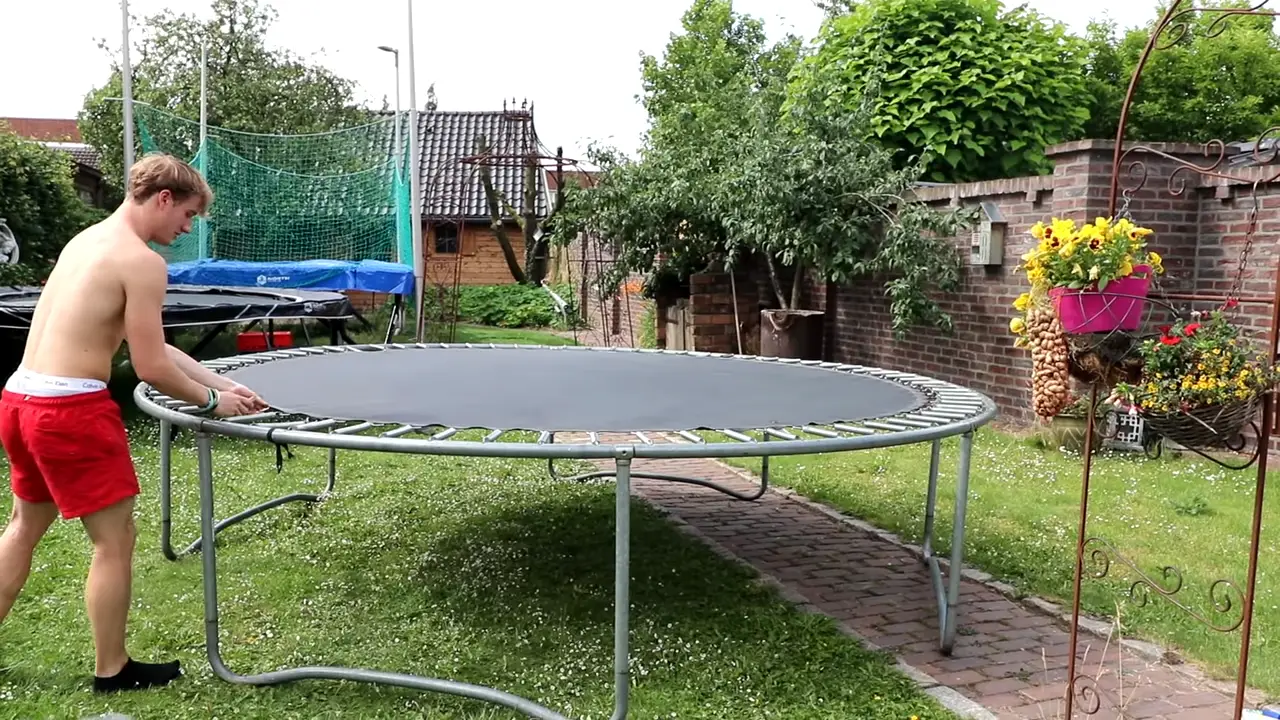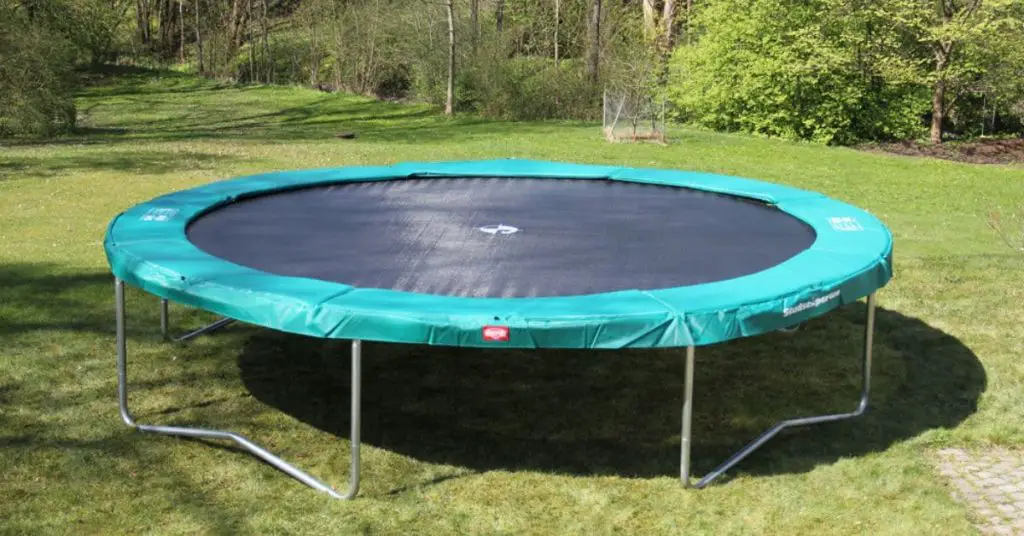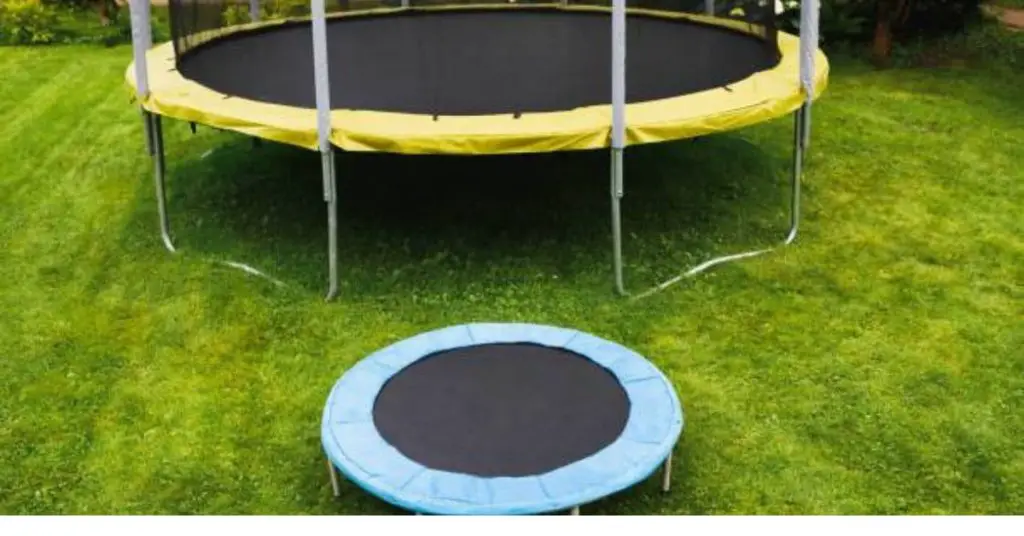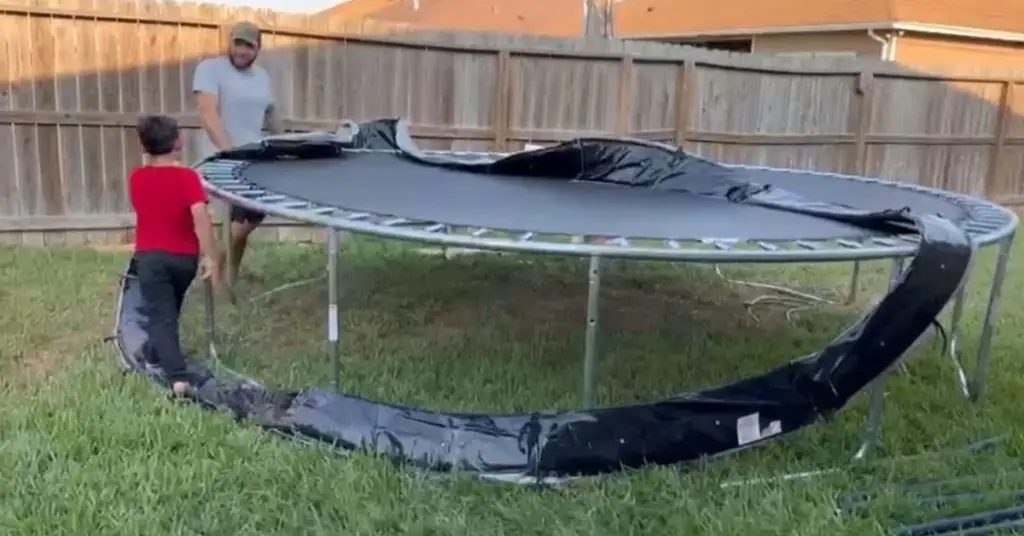The lifespan of a trampoline mat can vary depending on various factors, including the quality of the mat, frequency, and intensity of use, exposure to weather conditions, and maintenance practices.
In this article, we will explore the typical lifespan of a trampoline mat, variations based on usage and quality, and signs that indicate the need for replacement.
Understanding the expected lifespan of a trampoline mat is essential for maintaining a safe and enjoyable trampoline experience.
By knowing when to replace the mat, trampoline owners can ensure optimal performance, reduce the risk of accidents, and prolong the overall lifespan of the trampoline.
Whether you are a new trampoline owner or considering replacing an existing mat, this article will provide valuable insights into the lifespan of trampoline mats and offer guidance on when and how to assess their condition.
How long does a trampoline mat last: The lifespan of a trampoline mat typically ranges from 3 to 8 years. Factors like usage, quality, and maintenance practices influence its durability. Regular inspection helps identify when replacement is needed for safety reasons.
Importance of a Trampoline Mat

The trampoline mat plays a crucial role in a trampoline’s overall performance and safety. Here are some key reasons why the trampoline mat is of utmost importance:
Bounce Quality and Performance:
The trampoline mat’s design and construction directly impact the quality of the bounce. It should offer sufficient tension and elasticity to provide a responsive and controlled bounce, allowing users to enjoy a fun and exhilarating jumping experience.
Shock Absorption and Impact Reduction:
The trampoline mat acts as a shock absorber, helping to reduce the impact on users’ joints and muscles. It absorbs much of the force generated during bouncing, promoting a lower-impact workout and minimizing the risk of injuries.
Structural Integrity and Stability:
The trampoline mat is a fundamental part of the trampoline’s structural integrity. It distributes the weight of the users evenly across the frame, ensuring stability and preventing excessive stress on individual springs or other components.
Safety and Injury Prevention:
A properly functioning trampoline mat is essential for user safety. It should be free from tears, holes, or excessive stretching, which could pose a risk of tripping, entrapment, or falling through the mat. A well-maintained trampoline mat reduces the likelihood of accidents and injuries.
Longevity and Durability:
When properly cared for, a high-quality trampoline mat can have a longer lifespan. It is designed to withstand the rigors of regular use, resist weathering from exposure to the elements, and maintain its structural integrity over time. This longevity ensures that users can enjoy their trampoline for years to come.
How Long Does a Trampoline Mat Last?

A trampoline mat is a vital component providing users with a jumping surface. The lifespan of a trampoline mat can vary depending on several factors.
Understanding these factors is crucial for maintaining a safe and enjoyable trampoline experience. In this section, we will explore the key factors that affect the lifespan of a trampoline mat.
Quality of the Mat
Material used: The type of material used in constructing a trampoline mat plays a significant role in its lifespan. High-quality trampoline mats are typically made of durable materials such as polypropylene or polyethylene.
These materials are known for their strength, resistance to UV rays, and ability to withstand continuous jumping without losing their elasticity. In contrast, lower-quality mats made from inferior materials may deteriorate more quickly, leading to a shorter lifespan.
Manufacturing process: The manufacturing process also impacts the quality and durability of a trampoline mat. Mats produced using advanced manufacturing techniques, such as precision stitching and reinforced edging, will likely have a longer lifespan.
On the other hand, mats with subpar construction and inadequate stitching may be prone to premature wear and tear.
Frequency and Intensity of Use:
The frequency and intensity of trampoline usage directly affect the mat’s lifespan. Trampolines that are used more frequently or by individuals who engage in intense jumping activities may experience more significant wear and tear.
Constant jumping and high-impact landings exert stress on the mat, leading to stretching, tearing, or loss of elasticity over time. Therefore, trampolines used for recreational purposes with moderate usage tend to have a longer mat lifespan compared to those used for rigorous activities like gymnastics or acrobatics.
Exposure to Weather Conditions:
The exposure of a trampoline mat to various weather conditions can significantly impact its lifespan. Continuous exposure to direct sunlight can cause the mat’s material to deteriorate faster due to UV radiation.
Additionally, extreme temperatures, moisture, rain, snow, and wind can all contribute to the degradation of the mat. Prolonged exposure to harsh weather conditions can weaken the material, leading to fading, brittleness, and reduced elasticity.
To prolong the mat’s lifespan, it is essential to protect the trampoline from prolonged exposure to the elements when not in use, either by using a cover or storing it indoors.
Maintenance and Care:
Proper maintenance and care are crucial for extending the lifespan of a trampoline mat. Regular mat cleaning helps remove dirt, debris, and contaminants that can cause damage over time.
Use a mild detergent, water solution, and a soft brush or cloth to gently clean the mat. Avoid harsh chemicals or abrasive materials that degrade the mat’s surface.
Inspecting the mat regularly for signs of wear and tear is vital. Look for any loose stitching, tears, or holes that may compromise the mat’s integrity. Addressing such issues promptly can prevent further damage and ensure the safety of users.
Proper storage during periods of non-use is another important aspect of maintenance. Storing the trampoline indoors or using a weatherproof cover can shield the mat from environmental factors that could accelerate its deterioration.
Disassembling the trampoline during severe weather conditions, such as storms or heavy winds, is also advisable to avoid unnecessary strain on the mat.
Finally, following the manufacturer’s guidelines and recommendations for maintaining and caring for the trampoline mat is essential. These guidelines may include weight limits, restrictions on jumping techniques, and advice on how to properly secure the mat to the trampoline frame.
Typical Lifespan of a Trampoline Mat

A trampoline mat is subjected to continuous stress and wear; it will naturally deteriorate over time. Understanding the typical lifespan of a trampoline mat is important for planning maintenance and replacement strategies.
This section will explore the general range of a trampoline mat’s lifespan, variations based on usage and quality, and the signs of wear and tear that indicate the need for replacement.
The General Range of Lifespan
The lifespan of a trampoline mat can vary depending on several factors. On average, a well-maintained trampoline mat can last between 3 to 8 years.
However, it’s important to note that this is a general estimate, and individual experiences may vary. Some mats may last even longer, while others may require replacement sooner.
Variations Based on Usage and Quality
The lifespan of a trampoline mat is influenced by the frequency and intensity of usage, as well as the quality of the mat itself. Trampolines that experience light to moderate usages, such as occasional recreational jumping, are likelier to have a longer mat lifespan.
On the other hand, trampolines used for vigorous activities like gymnastics, acrobatics, or competitive training will experience more strain and may require more frequent mat replacements.
The quality of the mat also plays a significant role. Higher-quality trampoline mats, constructed with durable materials and superior manufacturing processes, tend to last longer than lower-quality mats. Investing in a higher-quality mat upfront can result in a more extended lifespan and better overall performance.
Signs of Wear and Tear Indicating a Replacement
Several signs indicate that a trampoline mat is nearing the end of its lifespan and requires replacement. It is important to regularly inspect the mat for the following signs of wear and tear:
Visible tears or holes:
Any significant tears or holes in the mat can compromise its structural integrity and pose safety risks. If the tears are large or multiple, it is advisable to replace the mat.
Excessive stretching:
Over time, a trampoline mat may stretch due to frequent use. However, if the stretching becomes excessive, causing the mat to sag or lose its original shape, it indicates that the mat has reached the end of its lifespan.
Faded or discolored material:
Continuous exposure to sunlight can cause the mat’s color to fade or become discolored. While this may not necessarily affect the mat’s performance, it can be an aesthetic concern. However, replacement should be considered if other signs of wear accompany the fading.
Loss of elasticity:
The mat should have a firm and responsive surface. If you notice that the mat has become overly elastic, with a reduced bounce or increased sagging, it may indicate that it has worn out and needs replacing.
Loose stitching or damaged edging:
Check the stitching around the mat’s perimeter and ensure that it is secure. If the stitching is loose or the edging is damaged, it can lead to further tearing and pose safety hazards.
It is important not to overlook these signs of wear and tear. Continuing to use a worn-out trampoline mat can increase the risk of accidents and injuries. When any of these signs become evident, replacing the trampoline mat promptly is recommended to maintain a safe and enjoyable jumping experience.
Extending the Lifespan of a Trampoline Mat

It is important to follow proper maintenance and care practices to maximize the lifespan of a trampoline mat and ensure a safe and enjoyable jumping experience.
In this section, we will explore key strategies for extending the lifespan of a trampoline mat.
Regular cleaning and maintenance
Regular cleaning removes dirt, debris, and contaminants that can accumulate on the trampoline mat over time. Here are some tips for proper cleaning and maintenance:
Use a soft brush or cloth:
Gently scrub the mat’s surface using a soft brush or cloth. Avoid using abrasive materials that can damage the mat.
A mild detergent and water solution:
Prepare a solution of mild detergent and water and use it to clean the mat. Ensure that the detergent is suitable for the mat’s material and avoid using harsh chemicals.
Rinse thoroughly:
After cleaning, rinse the mat thoroughly with clean water to remove any detergent residue.
Allow proper drying:
Allow the mat to dry completely before using it again. This helps prevent moisture accumulation and potential damage.
Proper storage during periods of non-use
Proper storage is crucial to protect the mat from unnecessary wear and tear when the trampoline is not in use. Consider the following storage recommendations:
Indoor storage:
If possible, store the trampoline indoors during periods of non-use. This protects the mat from exposure to harsh weather conditions, UV radiation, and other elements that can accelerate its deterioration.
Weatherproof cover:
If indoor storage is not an option, use a weatherproof cover specifically designed for trampolines. The cover should be securely fastened to protect the mat from rain, snow, sunlight, and debris.
Disassemble if necessary:
In extreme weather conditions, such as storms or heavy winds, it is advisable to disassemble the trampoline and store the mat and other components in a safe place until the weather improves.
Protection from harsh weather conditions
Exposure to harsh weather conditions can significantly impact the lifespan of a trampoline mat. Protect the mat by taking the following precautions:
Use a UV-resistant mat: Consider purchasing a trampoline mat that is specifically designed to withstand UV radiation. UV-resistant mats are made from materials that can resist fading and degradation caused by sun exposure.
Install a canopy or shade cloth: If your trampoline is located in an area with direct sunlight, consider installing a canopy or shade cloth to protect it from intense UV rays. This helps prevent excessive fading and deterioration of the mat.
Remove snow and ice: During winter months, remove any accumulated snow or ice from the trampoline to prevent unnecessary weight and stress on the mat. Excessive weight can cause stretching and damage.
Limiting excessive weight and usage
Excessive weight and intense usage can accelerate the wear and tear of a trampoline mat. Here are some recommendations to minimize strain on the mat:
Follow weight limits: Adhere to the weight limits specified by the trampoline manufacturer. Exceeding the weight capacity can cause the mat to stretch excessively, leading to reduced elasticity and a shorter lifespan.
Limit simultaneous users: Avoid overcrowding the trampoline with multiple users beyond its intended capacity. Overloading the mat with excessive weight can cause stress and increase the risk of damage.
Educate users on safe jumping techniques: Teach users proper jumping techniques, such as jumping near the center of the mat and avoiding jumps near the edges or springs. This helps distribute the weight evenly and reduces strain on the mat.
By following these practices, you can significantly extend the lifespan of a trampoline mat. Regular cleaning and maintenance, proper storage, protection from harsh weather conditions, and limiting excessive weight and usage all contribute to a longer-lasting mat and a safer trampoline experience.
Tips for Evaluating Trampoline Mat Condition
Regularly evaluating the condition of a trampoline mat is crucial for identifying any potential issues or signs of wear and tear. By conducting thorough assessments, you can ensure the safety and functionality of the mat. Here are some tips for evaluating the condition of a trampoline mat:
Visual inspection for signs of damage

Examine the entire mat: Conduct a visual inspection of the entire trampoline mat, paying close attention to the surface, edges, and stitching. Look for any visible signs of damage, such as tears, holes, or fraying.
Check for discoloration: Observe if the mat has experienced significant color fading or discoloration. While this may not affect the mat’s performance, it can indicate prolonged exposure to sunlight and potential material degradation.
Testing mat tension and elasticity
Test the mat’s tension: Stand in the center of the trampoline and press down on the mat with your hands. The mat should have a firm and responsive tension. If it feels loose or saggy, it may indicate stretching or loss of elasticity.
Jump test: Perform a few gentle jumps on different mat areas. Pay attention to how the mat responds. It should provide a consistent and controlled bounce. If you notice excessive sagging, uneven tension, or irregular bouncing, it may indicate a compromised mat.
Checking for loose stitching or tears
Inspect the stitching: Examine the stitching around the mat’s perimeter and any connecting seams. Check for loose or unraveling stitching. Loose stitching can lead to further tearing and pose safety risks.
Look for tears or holes: Carefully inspect the entire surface of the mat for any tears or holes. Even small tears can gradually worsen over time, compromising the mat’s integrity.
Seeking professional assessment if unsure
Consult the manufacturer: If you have concerns about the condition of your trampoline mat, reach out to the manufacturer. They can provide guidance and specific recommendations based on the make and model of your trampoline.
Seek professional assistance: If you are unsure about evaluating the mat’s condition or if you notice significant damage, it may be wise to seek help from a professional trampoline technician. They have the expertise to assess the mat’s condition and recommend appropriate action, whether it be repair or replacement.
Remember, safety should always be a priority when using a trampoline. If you have any doubts about the condition of the mat, it is better to err on the side of caution and address the issue promptly.
By following these tips, you can effectively evaluate the condition of a trampoline mat, identify any potential problems, and take appropriate measures to ensure a safe and enjoyable trampoline experience.
Replacement Options for Trampoline Mats
When a trampoline mat reaches the end of its lifespan or sustains significant damage, it is important to consider replacement options to maintain a safe and functional trampoline. Here are some options for replacing a trampoline mat:
Related article: How Long Do Trampolines Last
Ordering a replacement from the manufacturer

Contact the manufacturer: Reach out to the manufacturer of your trampoline to inquire about purchasing a replacement mat. They can provide information on the availability of replacement mats specifically designed for your trampoline model.
Provide necessary information: When contacting the manufacturer, be prepared to provide specific details about your trampoline, such as the model, size, and year of purchase. This helps ensure you receive the correct replacement mat that properly fits your trampoline.
Follow manufacturer guidelines: When ordering a replacement mat from the manufacturer, carefully follow their guidelines for installation and any additional recommendations for maintaining the trampoline’s safety and performance.
Seeking assistance from a professional trampoline technician
Consult with a trampoline technician: If you are unsure about the replacement process or prefer professional assistance, consider contacting a trampoline technician. They have expertise in trampoline maintenance and can guide you through the replacement process.
Professional installation: A trampoline technician can assist with properly installing the replacement mat, ensuring that it is securely attached to the trampoline frame and meets safety standards. They can also inspect other components of the trampoline to ensure their overall condition and functionality.
DIY replacement options and considerations
Research and purchase a compatible replacement mat: If you are comfortable with DIY projects and have the necessary tools, you can independently research and purchase a replacement mat. Look for reputable retailers that offer trampoline mats compatible with your trampoline’s specifications.
Follow installation instructions: When replacing the mat yourself, follow the instructions provided. Make sure to secure the mat properly to the trampoline frame, paying attention to any specific attachment methods recommended by the manufacturer.
Safety considerations: Prioritize safety during the DIY replacement process. Ensure that you have a clear understanding of the proper installation procedures, including tightening bolts and fasteners and securing the mat to prevent any potential hazards.
Consider professional guidance if needed: If you encounter difficulties during the DIY replacement process or have safety concerns, do not hesitate to seek assistance from a trampoline technician. They can provide guidance and ensure that the replacement is done correctly.
Remember, the replacement process is an opportunity to improve the safety and performance of your trampoline. Consider the quality and durability of the replacement mat to ensure a longer lifespan and a safer jumping experience.
Whether you choose to order a replacement from the manufacturer, seek professional assistance, or opt for a DIY replacement, it is important to prioritize safety and follow the recommended guidelines to maintain a well-functioning trampoline.
Maintenance and Care Tips
Certainly, here are some maintenance and care tips to help extend the lifespan of your trampoline mat:
- Regular Cleaning: Sweep or hose down the trampoline mat to remove dirt, leaves, and debris. Use a mild detergent and water to clean stubborn stains. Avoid using harsh chemicals that might damage the mat’s surface.
- Debris Removal: Check the mat and frame for any debris, such as leaves, twigs, or toys, before each use. These objects can cause damage to the mat over time.
- Proper Storage: During off-seasons or periods of non-use, consider disassembling the trampoline and storing it indoors or in a sheltered area. This protects the mat from prolonged exposure to harsh weather conditions.
- Protective Covers: Invest in a weather-resistant cover designed for trampolines. These covers shield the mat and spring from UV rays, rain, and debris, helping to prevent premature deterioration.
- Attachment Points: Regularly check and tighten the attachment points, including springs and frame connections. Loose or damaged attachments can strain the mat and lead to tears or stretching.
- Inspect Springs and Frame: Periodically inspect the springs and frame for signs of rust or corrosion. Replace any rusty components promptly to prevent weakening and potential safety hazards.
- Avoid Overloading: Follow the manufacturer’s weight recommendations and guidelines for the number of users at a time. Overloading the trampoline can put excessive stress on the mat and springs.
- Rotating Mat and Springs: Occasionally rotate the mat and springs to distribute wear and tear more evenly. This prevents specific areas from deteriorating faster than others.
- Use Protective Footwear: Encourage users to wear socks or soft-soled shoes while jumping. This reduces friction on the mat’s surface and minimizes the chances of causing abrasions.
- Check for Damage: Regularly inspect the trampoline mat for signs of wear and tear, including fading, fraying, tears, or holes. Address any issues promptly to prevent further damage.
- Avoid Sharp Objects: Keep sharp objects, pets, and pointed accessories away from the trampoline to prevent accidental damage to the mat.
- Keep it Dry: If the mat becomes wet due to rain or cleaning, allow it to dry completely before using it again. Moisture can accelerate wear and lead to mold or mildew growth.
- Follow Safety Guidelines: Ensure that users follow proper jumping techniques and guidelines to minimize unnecessary stress on the trampoline mat.
- Replace Components When Needed: If you notice significant wear, tear, or damage to the mat or springs, consider replacing them with manufacturer-recommended parts. Using non-compatible components can compromise safety and performance.
Remember, regular maintenance and care not only extend the life of your trampoline mat but also contribute to the overall safety and enjoyment of the trampoline for users.
FAQs:
Q.1 How long does a trampoline mat typically last?
A trampoline mat’s lifespan can vary, but on average, it can last between 3 to 8 years with proper care and maintenance.
Q.2 What factors can affect the lifespan of a trampoline mat?
Several factors can influence the lifespan of a trampoline mat, including the quality of the mat, frequency and intensity of use, exposure to weather conditions, and maintenance and care practices.
Q.3 Can a trampoline mat last longer than 8 years?
While the average lifespan of a trampoline mat is 3 to 8 years, some mats may last longer depending on factors such as usage, quality, and maintenance. Conversely, some mats may require replacement sooner due to heavier usage or poor maintenance.
Q.4 How can I determine if my trampoline mat needs to be replaced?
Signs that indicate the need for trampoline mat replacement include visible tears or holes, excessive stretching or sagging, faded or discolored material, loss of elasticity, and loose stitching or damaged edging.
Q.5 Can I repair a damaged trampoline mat instead of replacing it?
Repairing a trampoline mat is possible for minor issues like small tears or holes. However, it is generally recommended to replace the mat if the damage is significant or compromises its structural integrity. Repairing the mat may not provide the same level of safety and performance as a new one.
Q.6 How can I extend the lifespan of my trampoline mat?
To extend the lifespan of a trampoline mat, practice regular cleaning and maintenance, store the trampoline properly during periods of non-use, protect it from harsh weather conditions, and avoid excessive weight and usage.
Q.7 Where can I purchase a replacement trampoline mat?
Replacement trampoline mats can often be purchased directly from the manufacturer of your trampoline. Alternatively, there are reputable retailers that offer compatible replacement mats. Ensuring that the replacement mat is the correct size and compatible with your trampoline model is important.
Conclusion:
In conclusion, understanding the lifespan of a trampoline mat is essential for maintaining a safe and enjoyable trampoline experience. The quality of the mat plays a significant role in its durability, as a high-quality mat made from durable materials and manufactured with care is more likely to last longer.
Factors such as frequency and intensity of use, exposure to weather conditions, and proper maintenance also affect the mat’s lifespan. Regular cleaning, storage during non-use periods, protection from harsh weather, and limiting excessive weight and usage can help extend the mat’s lifespan.
It is important to regularly evaluate the mat’s condition through visual inspections, tension and elasticity testing, and checking for loose stitching or tears. If unsure about the mat’s condition, seeking professional assessment is advisable.
When replacement becomes necessary, ordering a replacement from the manufacturer or seeking assistance from a professional trampoline technician are viable options.
Alternatively, DIY replacement can be considered, but proper research, compatible replacement selection, and adherence to installation instructions are essential.
By understanding these aspects, trampoline owners can maximize the longevity and performance of their trampoline mats.
We hope that this guide on how long a trampoline mat lasts has provided you with valuable information. If you have any questions, please feel free to leave a comment below.

